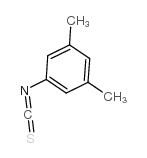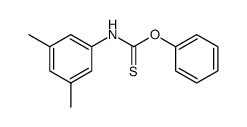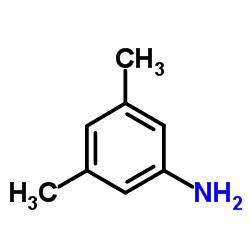3,5-dimethylphenyl isothiocyanate
Modify Date: 2024-01-09 13:23:17

3,5-dimethylphenyl isothiocyanate structure
|
Common Name | 3,5-dimethylphenyl isothiocyanate | ||
|---|---|---|---|---|
| CAS Number | 40046-30-8 | Molecular Weight | 163.23900 | |
| Density | 1.01 g/cm3 | Boiling Point | 140 °C | |
| Molecular Formula | C9H9NS | Melting Point | N/A | |
| MSDS | N/A | Flash Point | 127.3ºC | |
| Name | 1-isothiocyanato-3,5-dimethylbenzene |
|---|---|
| Synonym | More Synonyms |
| Density | 1.01 g/cm3 |
|---|---|
| Boiling Point | 140 °C |
| Molecular Formula | C9H9NS |
| Molecular Weight | 163.23900 |
| Flash Point | 127.3ºC |
| Exact Mass | 163.04600 |
| PSA | 44.45000 |
| LogP | 3.03770 |
| Index of Refraction | 1.6190 |
Synonym: Section 2 - COMPOSITION, INFORMATION ON INGREDIENTS
Risk Phrases: 20/21/22 36/37/38 Section 3 - HAZARDS IDENTIFICATION EMERGENCY OVERVIEW
Harmful by inhalation, in contact with skin and if swallowed. Irritating to eyes, respiratory system and skin.Moisture sensitive. Potential Health Effects Eye: Causes eye irritation. Lachrymator (substance which increases the flow of tears). Skin: Causes skin irritation. Harmful if absorbed through the skin. Ingestion: Harmful if swallowed. May cause irritation of the digestive tract. Inhalation: Harmful if inhaled. Causes respiratory tract irritation. Chronic: Not available. Section 4 - FIRST AID MEASURES Eyes: Flush eyes with plenty of water for at least 15 minutes, occasionally lifting the upper and lower eyelids. Get medical aid. Skin: Get medical aid. Flush skin with plenty of water for at least 15 minutes while removing contaminated clothing and shoes. Ingestion: Get medical aid. Wash mouth out with water. Inhalation: Remove from exposure and move to fresh air immediately. If not breathing, give artificial respiration. If breathing is difficult, give oxygen. Get medical aid. Notes to Physician: Section 5 - FIRE FIGHTING MEASURES General Information: As in any fire, wear a self-contained breathing apparatus in pressure-demand, MSHA/NIOSH (approved or equivalent), and full protective gear. Extinguishing Media: Use foam, dry chemical, or carbon dioxide. Section 6 - ACCIDENTAL RELEASE MEASURES General Information: Use proper personal protective equipment as indicated in Section 8. Spills/Leaks: Absorb spill with inert material (e.g. vermiculite, sand or earth), then place in suitable container. Section 7 - HANDLING and STORAGE Handling: Avoid breathing dust, vapor, mist, or gas. Avoid contact with skin and eyes. Use only in a chemical fume hood. Storage: Store in a cool, dry place. Store in a tightly closed container. Store under an inert atmosphere. Section 8 - EXPOSURE CONTROLS, PERSONAL PROTECTION Engineering Controls: Facilities storing or utilizing this material should be equipped with an eyewash facility and a safety shower. Use adequate ventilation to keep airborne concentrations low. Exposure Limits CAS# 40046-30-8: Personal Protective Equipment Eyes: Not available. Skin: Wear appropriate protective gloves to prevent skin exposure. Clothing: Wear appropriate protective clothing to prevent skin exposure. Respirators: Follow the OSHA respirator regulations found in 29 CFR 1910.134 or European Standard EN 149. Use a NIOSH/MSHA or European Standard EN 149 approved respirator if exposure limits are exceeded or if irritation or other symptoms are experienced. Section 9 - PHYSICAL AND CHEMICAL PROPERTIES Physical State: Liquid Color: colorless - pale yellow Odor: Not available. pH: Not available. Vapor Pressure: Not available. Viscosity: Not available. Boiling Point: 140 - 142 deg C @15mmHg Freezing/Melting Point: Not available. Autoignition Temperature: Not available. Flash Point: Not available. Explosion Limits, lower: Not available. Explosion Limits, upper: Not available. Decomposition Temperature: Solubility in water: Specific Gravity/Density: Molecular Formula: C9H9NS Molecular Weight: 163.24 Section 10 - STABILITY AND REACTIVITY Chemical Stability: Not available. Conditions to Avoid: Incompatible materials, exposure to moist air or water. Incompatibilities with Other Materials: Bases, oxidizing agents, reducing agents, amines. Hazardous Decomposition Products: Carbon monoxide, oxides of nitrogen, oxides of sulfur, carbon dioxide. Hazardous Polymerization: Has not been reported Section 11 - TOXICOLOGICAL INFORMATION RTECS#: CAS# 40046-30-8 unlisted. LD50/LC50: Not available. Carcinogenicity: 3,5-Dimethylphenyl isothiocyanate - Not listed by ACGIH, IARC, or NTP. Section 12 - ECOLOGICAL INFORMATION Section 13 - DISPOSAL CONSIDERATIONS Dispose of in a manner consistent with federal, state, and local regulations. Section 14 - TRANSPORT INFORMATION IATA Shipping Name: TOXIC LIQUID, ORGANIC, N.O.S.* Hazard Class: 6.1 UN Number: 2810 Packing Group: III IMO Shipping Name: TOXIC LIQUID, ORGANIC, N.O.S. Hazard Class: 6.1 UN Number: 2810 Packing Group: III RID/ADR Shipping Name: TOXIC LIQUID, ORGANIC, N.O.S. Hazard Class: 6.1 UN Number: 2810 Packing group: III Section 15 - REGULATORY INFORMATION European/International Regulations European Labeling in Accordance with EC Directives Hazard Symbols: XN Risk Phrases: R 20/21/22 Harmful by inhalation, in contact with skin and if swallowed. R 36/37/38 Irritating to eyes, respiratory system and skin. Safety Phrases: S 26 In case of contact with eyes, rinse immediately with plenty of water and seek medical advice. S 36/37/39 Wear suitable protective clothing, gloves and eye/face protection. WGK (Water Danger/Protection) CAS# 40046-30-8: No information available. Canada None of the chemicals in this product are listed on the DSL/NDSL list. CAS# 40046-30-8 is not listed on Canada's Ingredient Disclosure List. US FEDERAL TSCA CAS# 40046-30-8 is not listed on the TSCA inventory. It is for research and development use only. SECTION 16 - ADDITIONAL INFORMATION N/A |
| Hazard Codes | Xn:Harmful; |
|---|---|
| Risk Phrases | R20/21/22;R36/37/38 |
| Safety Phrases | S26-S36/37/39 |
| RIDADR | 2810 |
| Packaging Group | III |
| Hazard Class | 6.1 |
| HS Code | 2930909090 |
|
~98% 
3,5-dimethylphe... CAS#:40046-30-8 |
| Literature: Li, Zheng-Yi; Ma, Hong-Zhao; Han, Chen; Xi, Hai-Tao; Meng, Qi; Chen, Xin; Sun, Xiao-Qiang Synthesis (Germany), 2013 , vol. 45, # 12 art. no. SS-2013-F0228-OP, p. 1667 - 1674 |
|
~89% 
3,5-dimethylphe... CAS#:40046-30-8 |
| Literature: Li, Zheng-Yi; Ma, Hong-Zhao; Han, Chen; Xi, Hai-Tao; Meng, Qi; Chen, Xin; Sun, Xiao-Qiang Synthesis (Germany), 2013 , vol. 45, # 12 art. no. SS-2013-F0228-OP, p. 1667 - 1674 |
|
~% 
3,5-dimethylphe... CAS#:40046-30-8 |
| Literature: Li, Zheng-Yi; Ma, Hong-Zhao; Han, Chen; Xi, Hai-Tao; Meng, Qi; Chen, Xin; Sun, Xiao-Qiang Synthesis (Germany), 2013 , vol. 45, # 12 art. no. SS-2013-F0228-OP, p. 1667 - 1674 |
|
~% 
3,5-dimethylphe... CAS#:40046-30-8 |
| Literature: Yan, Shunqi; Appleby, Todd; Gunic, Esmir; Shim, Jae Hoon; Tasu, Tania; Kim, Hongwoo; Rong, Frank; Chen, Huaming; Hamatake, Robert; Wu, Jim Z.; Hong, Zhi; Yao, Nanhua Bioorganic and Medicinal Chemistry Letters, 2007 , vol. 17, # 1 p. 28 - 33 |
| HS Code | 2930909090 |
|---|---|
| Summary | 2930909090. other organo-sulphur compounds. VAT:17.0%. Tax rebate rate:13.0%. . MFN tariff:6.5%. General tariff:30.0% |
| 3,5-dimethylisothiocyanate |
| 3,5-dimethylbenzenisothiocyanate |
| 3,5-Dimethylphenyl isothiocyanate |
| MFCD00041082 |





